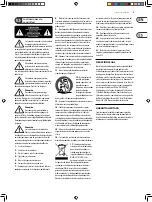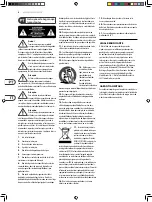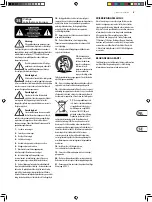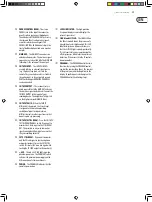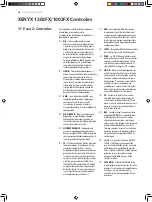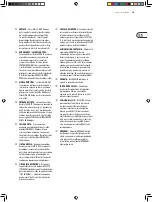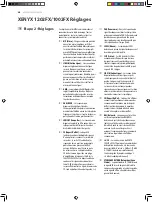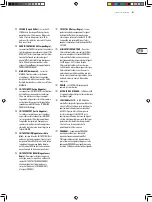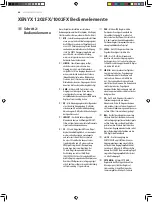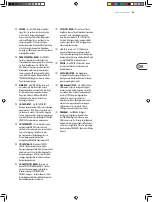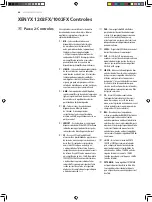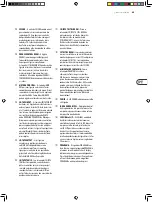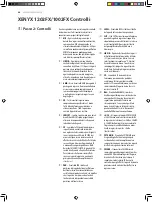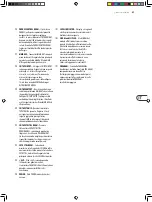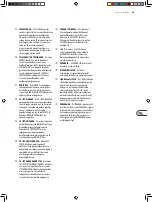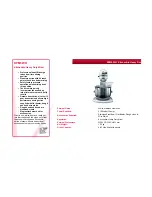
16
XENYX 1202FX/1002FX
XENYX 1202FX/1002FX Controls
(EN)
Step 2: Controls
This chapter describes the various control elements
of your mixing console. All controls, switches and
connectors will be discussed in detail.
(1)
MIC
– Each mono input channel o
ffers a
balanced microphone input via the XLR
connector and also features switchable
+48 V phantom power supply for condenser
microphones. The XENYX preamps provide
undistorted and noisefree gain as is typically
known only from costly outboard preamps.
(2)
LINE IN
– Each mono input also features
a balanced line input on a ¼" connector.
Unbalanced devices (mono jacks) can also be
connected to these inputs. Please remember
that you can only use either the microphone
or the line input of a channel at any one time.
You can never use both simultaneously!
(3)
GAIN
– Use the GAIN control to adjust the
input gain. This control should always be
turned fully counterclockwise whenever you
connect or disconnect a signal source to one
of the inputs.
(4)
EQ
– All mono input channels include a
3-band equalizer. All bands provide boost
or cut of up to 15 dB. In the central position,
the equalizer is inactive.
(5)
LOW CUT
– In addition, the mono channels
are equipped with a steep LOW CUT
filter designed to eliminate unwanted
low-frequency signal components.
(6)
FX
– FX sends enable you to feed signals via
a variable control from one or more channels
and sum these signals to a bus. The bus
appears at the console’s FX send output and
can be fed from there to an external effects
device. The return from the effects unit is then
brought back into the console on the stereo
channels. Each FX send is mono and features
up to +15 dB gain. In the 1002FX/1202FX,
the FX send is routed directly to the built-in
effects processor. To make sure that the
effects processor receives an input signal,
you shouldn’t turn this control all the way to
the left (-∞).
(7)
PAN
– The PAN control determines the
position of the channel signal within
the stereo image. This control features a
constant-power characteristic, which means
the signal is always maintained at a
constant level, irrespective of position in the
stereo panorama.
(8)
LEVEL
– The LEVEL control determines the
level of the channel signal in the main mix.
(9)
CLIP
– The CLIP LED’s of the mono channels
illuminate when the input signal is driven
too high, which could cause distortion. If this
happens, use the GAIN control to reduce
the preamp level until the LED does not
light anymore.
(10)
LINE IN
– Each stereo channel has two
balanced line level inputs on ¼" jacks for left
and right channels. If only the jack marked “L”
(left) is used, the channel operates in mono.
The stereo channels are designed to handle
typical line level signals. Both inputs will also
accept unbalanced jacks.
(11)
FX
– The FX sends of the stereo channels
function similar to those of the mono
channels. However, since the FX send buses
are both mono, a mono sum is first taken from
the stereo input before it is sent to the FX bus.
(12)
BAL
– The BAL(ANCE) control determines the
levels of left and right input signals relative
to each other before both signals are then
routed to the main stereo mix bus. If a channel
is operated in mono via the left line input,
this control has the same function as the PAN
control used in the mono channels.
(13)
+4/-10
– The stereo inputs of the XENYX
1002FX and 1202FX have an input sensitivity
switch which selects b4 dBu and
-10 dBV. At -10 dBV (home-recording level),
the input is more sensitive (requires less level
to drive it) than at +4 dBu (studio level).
(14)
FX TO MAIN
– The FX TO MAIN control feeds
the effects signal into the main mix. If the
control is turned all the way counterclockwise,
no effects signal is present in the sum signal of
the mixing console.
(15)
FX SEND
– The FX SEND connector outputs
the signal you picked up from the individual
channels using the FX controls. You can
connect this to the input of an external
effects device in order to process the FX bus’
master signal. Once an effects mix is created,
the processed signal can then be routed
from the effects device outputs back into a
stereo input.


